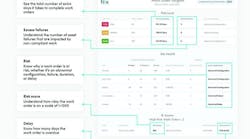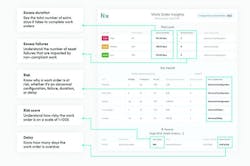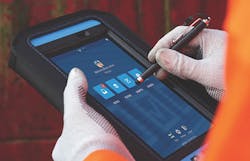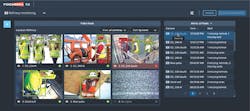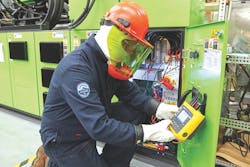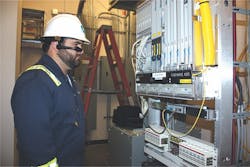Time for smarter PMs: How intelligent technologies are improving preventive maintenance routines
When budgets are tight, advanced maintenance strategies are reserved for the most critical assets. Predictive maintenance (PdM) and prescriptive maintenance (RxM) fall into this category, with timely intervention triggered by asset condition or performance anomalies. The other end of the spectrum is the run-to-failure (RTF) approach, which may be perfectly acceptable for non-crucial assets that have reasonable downtime and repair or replacement costs. In between is the widely used practice of preventive maintenance (PM).
Though an age-old strategy, PM is no stranger to innovation. Yes, the routine inspections, tests, servicing, and parts replacements are still systematically planned and scheduled based on time- or usage-based parameters. And yes, PM plans are still structured to occur in efficiently planned rounds or routes, with each stop on the route having an asset needing attention. But the notably increasing intelligence of PM-supporting applications and technologies is optimizing its execution and outcomes.
The advancements are an inevitable application of modern technological developments. Mobility and the industrial internet of things (IIoT) are transforming how data is collected and applied. Open standards and cloud computing are driving unprecedented connectivity, interoperability, and data democratization. Artificial intelligence (AI) and machine learning (ML) are powering advanced analytics and data-driven maintenance. Each of these is influencing the previously staid practice of PM.
Environmental, cultural, and competitive influences also play a role. For instance, the global disruption caused by COVID-19 influenced an entirely new set of safety practices for companies to enforce as well as heightened interest in remote work and automated processes.
Regardless of the motivation, ongoing upgrades in PM are furthering the core goals of asset owners and operators: improving safety, reliability, efficiency, and asset longevity while reducing downtime and maintenance costs.
This article describes some of the ways PM practices are getting smarter:
- PM process optimization
- Operator rounds optimization
- Health and safety optimization
- Strategic condition monitoring
- Digital, remote PM
- Advanced visualization
PM process optimization
Planning, scheduling, and completing PM rounds using unwieldy maintenance management software (EAM/CMMS) wastes time and energy. It also hinders the ability to improve work order effectiveness. These were challenges faced by the largest global producer of firefighting chemicals, Perimeter Solutions. Its Fire Safety Group’s previous software required users to manually go through every work order, one by one, and they found it difficult to derive value from the data.
The Fire Safety Group became an early adopter of Fiix Foresight, an AI-driven analytics solution from CMMS provider Fiix, a Rockwell Automation company. It also recently deployed Foresight’s latest feature, the Work Order Insights report. Together, the solutions are helping its maintenance teams to better focus on the issues and improve work order performance.
The Work Order Insights report uses ML algorithms to automatically analyze thousands of PM work orders in seconds (see Figure 1). Users are alerted to issues such as abnormal work order delays, maintenance routines not working or being followed, work being executed incorrectly, excessive rework, and wasteful maintenance processes – problems that can lead to costly breakdowns and production delays if left uncorrected.
“To be able to look into our data instead of just keeping track of work orders is really exciting for us,” says Jose Yorba, U.S. Asset Management in the Fire Safety Group at Perimeter Solutions. “We can start seeing things we have never seen in the past, like patterns of failures. And instead of just fixing the issues and moving on, we can now ask ‘why are those issues happening’? To identify that is hugely important.”
Operator rounds optimization
Operator-driven reliability programs call upon asset-facing operators to perform PM and inspection tasks. This practice is improving with new solutions that streamline operator route processes and reporting.
A large government research and development company’s previous technology for operator rounds was incompatible with mobile devices. Manually collected readings on all facility equipment were later manually entered into the system. Detailed explanations were input in cases where measurements were not collected.
To boost productivity, the company switched from its inflexible, outdated technology to the GoPlant mobile solution from SKF. Designed for use by operators in the field, the mobile app runs on smartphones and tablets and improves task management, data collection, and decision support (see Figure 2).
SKF’s technology team worked with the facility to develop complex workflows to increase efficiency and save time. SKF set up 58 routes that included more than 22,200 questions for the facility’s function, safety, and environmental areas. The GoPlant implementation was scheduled for a two-year setup, but successful collaboration with the teams allowed SKF to complete the project in nine months.
Now, the operation can efficiently collect data on mobile devices throughout the facility, analyze the data, create custom reports, and meet compliance requirements. The app provides contextual guidance about observed conditions as well as decision-support logic that leads the user through corrective actions or escalation procedures as needed. This ensures that best practices are followed by the operators when problems are encountered.
Health and safety optimization
Software that helps to keep workers safe in the field is valuable for personnel conducting PM or inspection rounds. The Lightning Health & Safety Solution Suite from FogHorn is designed to automate health and safety monitoring and enforce relevant workplace standards using edge AI, streaming video analytics, and IoT sensor fusion. Text and email alerts and dashboard visualization bring attention to risks and noncompliance in real time.
Aramco’s Wasit Gas Plant (WGP) in Saudi Arabia is testing the technology. “We are always welcoming new digital transformation initiatives, especially when it serves the safety of our employees,” says Abdulla O. Jallal, manager of WGP.
The suite includes out-of-the-box packages of preconfigured ML models and visualization dashboards that can be used individually or together. For instance, Lightning Safety solutions, such as personal protective equipment (PPE) detection and customized hazard detection, help to reduce injury and increase productivity. Lightning Health solutions currently include body temperature detection, social distancing monitoring, cough detection, mask detection, and hand washing monitoring to reduce contagion (see Figure 3).
All of FogHorn’s Lightning Solutions have embedded Edge AI. Rather than sending audio, video, thermal, vibration, or other streaming sensor data to a public or private cloud for processing, the deep-learning models are processed right at the edge and self-correct as conditions change over time.
“A lot of people think ML can’t be done at the edge, but we’ve obviously shown to the world that it can,” says Sastry Malladi, co-founder and CTO of FogHorn Systems in an interview with Greg Gorbach, a vice president at ARC Advisory Group. An upcoming collaboration between FogHorn and IBM will take the technology further by bringing together edge and cloud capabilities in a hybrid cloud platform with edge-powered AI capabilities.
Strategic condition monitoring
Condition monitoring technologies that collect real-time data facilitate routine inspections and accelerate strategic, data-driven decisions. For Crestline Sanitation District in California, this capability is helping to address its challenges of aging equipment, complex topology, increasing regulatory requirements, and growing service demands for its wastewater treatment plants and lift stations.
The maintenance team adopted the portable 3540 FC Three-Phase Power Monitor from Fluke along with Fluke Connect Condition Monitoring Software after alarms from a lift station signaled a potential raw sewage spill. The team quickly began running pumps by hand and was soon able to rule out mechanical issues, but they could not easily explain why the control system triggered the alarm. The portable power quality condition monitoring device helped to troubleshoot and identify the underlying cause.
Using power monitoring enabled them to see that the pumps, and ultimately the entire station, were not grounding properly. They isolated it down to harmonics and line voltage fluctuations that were causing varying amperages and variable frequency drive (VFD) anomalies. The findings drove the installation of a new station grounding system.
The team is now using the portable 3540 FC constantly to monitor pumps, motors, and entire systems to support energy efficiency studies and identify where upgrades are warranted. Besides reducing asset failures and the risk of sewage spills, energy costs are significantly reduced due to the maintenance team detecting and resolving motor inefficiencies and replacing energy-wasting motors. Bringing energy efficiency studies in-house also saves thousands of dollars.
Customers using Fluke Connect Cloud with Fluke Connect wireless test tools, such as the 3540 FC, can have the measurement data streamed wirelessly to the cloud for storage, analysis, reporting, and alarm notifications, or stored locally until there is an internet connection (see Figure 4).
Digital, remote PM
City and infrastructure PM is going digital with real-time, remote capabilities. Smart electric, gas, and water meters enable on-demand readings, inspections, and troubleshooting. Gas and water leak sensors, wastewater monitoring systems, and intelligent streetlights automatically send alerts when problems are detected. Timely alarms allow rapid dispatch of emergency crews, heightening the potential to save lives and avoid environmental damage.
Consolidated Edison (Con Edison), recently received approval to deploy 550G Gas Encoder Receiver Transmitter (ERT) modules from Itron at its gas facilities in New York State. With both advanced meter reading (AMR) and advanced meter infrastructure (AMI) capabilities, the modules support on-demand reads and high-flow safety alarms. They will be deployed on the utility’s existing Industrial IoT network from Itron.
Jude Del Percio of Con Edison’s AMI team says, “These gas modules have been rigorously tested in accordance with National Standards and NYS PSC requirements and feature the unique capability to operate with handheld and mobile AMR systems, equipping us to transition to our IoT network in certain service-territory areas without need for a field visit.”
Also connected to Con Edison’s IoT network are smart natural gas leak detectors from New Cosmos. The utility completed a pilot test with 9,000 of the battery-powered methane detectors in 2020 and is now deploying 376,000 of them for customers in New York City and Westchester County.
Advanced visualization
Augmented reality (AR) for PM provides technicians with superimposed, digital insights into the history, health, and performance of assets in real time. AR-enabled solutions, delivered via handheld or wearable devices, are included in the Connected Worker strategy from Hexagon.
Hexagon’s Connected Worker solution powered by Xalt leverages existing applications, systems, and IoT data to provide streamlined workflows for common work processes. Its AR-enabled solutions for smartphones, tablets, and headsets use advanced visualization technology to improve worker safety, efficiency, and effectiveness.
For example, the new Maintenance Execution 2.0 package pairs Hexagon’s Xalt Mobility software with assisted-reality, voice-enabled headsets from RealWear. Using verbal commands, information such as work orders, schematics, 3D models, GIS information, and safety documentation are beamed in front of the technician via the headset (see Figure 5). Real-time hazard notifications and near-miss reporting help to improve safety and enable traceability for audits and investigations.
The solution also enables real-time collaboration with experts. For instance, using the headset’s two-way video, a remote supervisor can see what the asset-facing technician sees, allowing for live guidance and observation as instructions are followed.
Similarly, the Xalt Real Time Monitoring (RTM) app brings AR to the shop floor. Users map out points of interest on the plant floor, such as stops along a PM route, and generate associated QR codes linking to relevant documents, videos, CAD models, point clouds, and more. During their rounds, technicians scan the code from their mobile device or headset to pull up and utilize the digital information in real time.
Assets of moderate criticality are nonetheless critical to the operation and deserving of optimized maintenance practices. The continuing advancements in PM tools and processes are putting maintenance teams on more solid footing, whether making rounds in the plant or online from remote. Building smart capabilities into this popular strategy allows routes to be completed more efficiently and effectively, leading to greater uptime and reliability. The more connected, automated, and intelligent the solution, the more value plants can derive from their PM programs and outcomes.
